
|
|
August 14-21, 2002
Mount Mansfield, Vermont
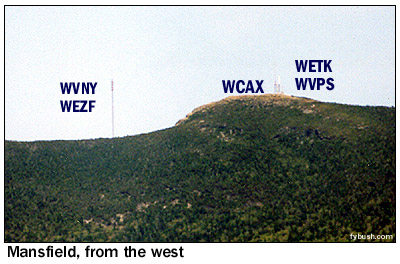 At
4393 feet above sea level, Mount Mansfield is the highest spot
in the state of Vermont, towering hundreds of feet above its
mountaintop neighbors in the range of peaks that rises from Lake
Champlain, separating Burlington and vicinity from the central
parts of the state.
At
4393 feet above sea level, Mount Mansfield is the highest spot
in the state of Vermont, towering hundreds of feet above its
mountaintop neighbors in the range of peaks that rises from Lake
Champlain, separating Burlington and vicinity from the central
parts of the state.
With a clear line of sight that stretches from the Adirondack Mountains far across the lake to the west (and the entire Burlington area), north into southern Quebec and east across much of northern Vermont, it was a natural place for television transmission to begin in the Green Mountain State.
The owners of WCAX radio in Burlington (AM 620, now WVMT) spent the summer of 1954 building a site on the "nose" of the mountain, just south of and a bit lower than the mountain's peak at the "chin" (the mountain's profile is said to resemble that of a face resting on its side, you see); and on September 11, 1954, WCAX-TV, channel 3, signed on with a test pattern as the first television station in Vermont. (Viewers with good antennas in the Burlington area would by then have had access to Montreal's CBFT, channel 2, for two years; those in southern Vermont would have been able to receive stations from Schenectady and Boston, and WMTW-TV, channel 8, would begin broadcasting from Mount Washington, N.H. to much of Vermont just two weeks later, on September 25, the day before actual WCAX-TV programming commenced.)
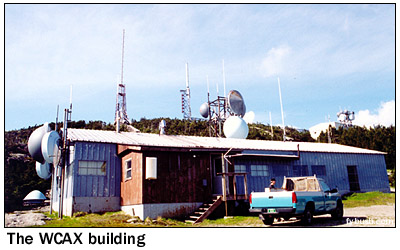 While
winters on Mansfield were far less brutal than on Mount Washington,
nearly 2000 feet higher, conditions were considered harsh enough
that it was desirable to have full-time engineering staff living
at the transmitter site. So the building that went up just below
the WCAX antenna included living quarters, and to this day the
channel 3 facility on Mansfield is staffed year-round by a crew
of engineers. With the abandonment of WMTW's mountaintop site
earlier in 2002, your editor believes that leaves WCAX as the
only station in New England with year-round residents at its
transmitter site.
While
winters on Mansfield were far less brutal than on Mount Washington,
nearly 2000 feet higher, conditions were considered harsh enough
that it was desirable to have full-time engineering staff living
at the transmitter site. So the building that went up just below
the WCAX antenna included living quarters, and to this day the
channel 3 facility on Mansfield is staffed year-round by a crew
of engineers. With the abandonment of WMTW's mountaintop site
earlier in 2002, your editor believes that leaves WCAX as the
only station in New England with year-round residents at its
transmitter site.
In any event, WCAX had the mountaintop to itself for its first 13 years on the air, even as the slopes of the hill below began to get crowded with the increasing popularity of the Stowe and Smuggler's Notch ski areas. (In fact, the Mount Mansfield Auto Road, open to the public as a toll road during the summer, doubles as a ski run during the winter, with WCAX staffers using a Sno-Cat to head up the mountain to trade shifts at the transmitter building.)
On October 16, 1967, Mansfield doubled its TV population with the debut of WETK, channel 33, the first station of what would eventually be known as "Vermont ETV" and later as "Vermont Public Television." Channel 33 built a tower of its own on the "nose," right next to the WCAX tower, with a transmission line leading down the slope of the hill to a transmitter building just above the WCAX facility. (In the photo above, the WCAX tower is the leftmost one on the hill, with WETK just to the right. You can see the WETK transmitter building at the very right of the picture, nestled in the trees above the WCAX building.)
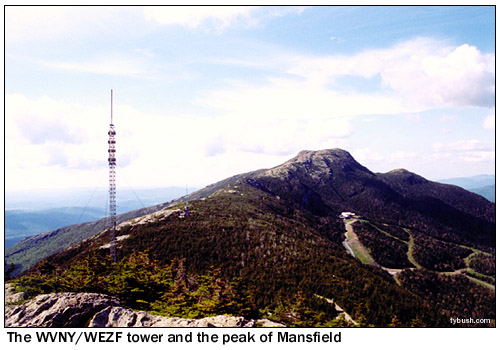
The following summer saw the construction of a new tower on the mountain, this one down lower in the little notch that separates the "nose" and "chin," where the visitor's center now greets visitors at the end of the public portion of the auto road. While the new tower was down a bit lower, it was built taller than the WCAX and WETK towers and heavily guyed against winter storms. On August 19, 1968, the new tower signed on with ABC programming as WVNY-TV, the calls standing for "Vermont" and "New York," the two states that made up the Burlington/Plattsburgh TV market (WCAX handled CBS programming; NBC came from the New York side via WPTZ Channel 5, licensed to North Pole and later to Plattsburgh.)
One summer later, FM radio came to the mountaintop with the debut of WVNY(FM) on 92.9, which signed on July 19, 1969, just in time to announce the moon landing. While Burlington had had FM radio since 1962, the existing stations (WJOY-FM on 98.9, now WOKO, and the University of Vermont's WRUV on 90.1) were down in the lowlands near the lake, with low power that just covered Burlington and vicinity. The 92.9 signal, with 36 kilowatts from 2700 feet above average terrain, covered most of Vermont and good chunks of Quebec, New York and New Hampshire to boot, and remains the best FM signal in northern Vermont, and perhaps in the entire state, to this day.
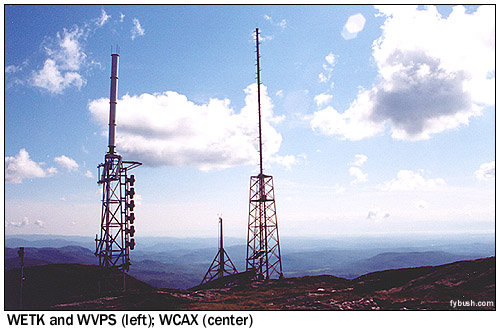
The last station to arrive on the mountaintop - for now, anyway - debuted on October 15, 1980. WVPS(FM), on 107.9 with 36 kilowatts, represented a huge leap forward for fledgling Vermont Public Radio, which had been on the air for three years by then (this week, in fact, marks the network's 25th anniversary), but only on the WVPR 89.5 Windsor signal that reaches the eastern parts of Vermont. Just as 92.9 (by then WEZF, matching the changed calls on WEZF-TV 22) had used the existing channel 22 tower, WVPS became a tenant on the channel 33 tower; you can see its six bays on the left-hand tower in the photo above. WVPS eventually boosted power to 49 kW, just as WEZF boosted its power to 46 kW; while both have excellent signals, WEZF's location higher above the mountaintop on a panel antenna eliminates some reflections and multipath problems that WVPS suffers on its lower side-mounted antenna.
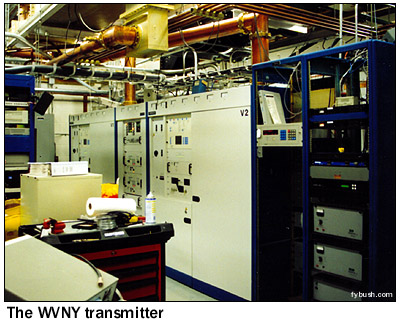
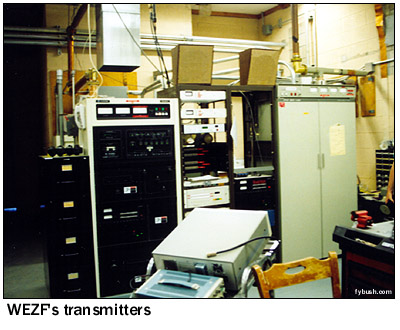
A visit to the mountain today begins at the end of the road at the visitor's center - but not in front! Walk around the side, and if you're lucky (as we were during a mid-June visit) the engineers from channel 22 will be around to welcome you into their transmitter room at the rear of the building.
As you can see from the photos above, channel 22 and FM 92.9 still share a transmitter room, even though the stations are no longer co-owned. Channel 22 has reverted to the WVNY calls, while 92.9, still WEZF, is a Clear Channel outlet doing an AC format as "Star 92.9."
The old Gates on the right of the WEZF-FM photo is probably the original 92.9 transmitter, long since replaced by the newer Harris; the Comark transmitter WVNY uses is most certainly not the original channel 22 transmitter from three decades ago!
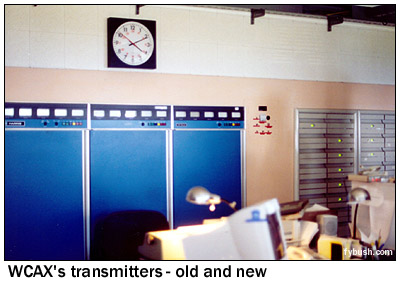 Alert drivers up
the Mount Mansfield road will have seen a little turnoff just
before the top of the road - another road marked "WCAX TV
Only." If you're a tower geek, it's OK to take the turnoff
and follow the dirt road around the back of the WVNY/WEZF tower
and up the ledge to the WCAX building, where there's always an
engineer around, happy to talk shop for a few minutes.
Alert drivers up
the Mount Mansfield road will have seen a little turnoff just
before the top of the road - another road marked "WCAX TV
Only." If you're a tower geek, it's OK to take the turnoff
and follow the dirt road around the back of the WVNY/WEZF tower
and up the ledge to the WCAX building, where there's always an
engineer around, happy to talk shop for a few minutes.
The WCAX transmitter room is full of neat gear, including the very old Harris-badged transmitter seen at left (a last-resort backup) and the much newer Harris that is the primary transmitter, part of which can be seen at right. This was one of the first of the Harris solid-state transmitters, and has proven its reliability in this challenging environment for close to 15 years now. Additional racks along the side of the big transmitter room hold processing and monitoring gear, the control rack for the new Harris, and lots of microwave gear to handle studio-transmitter links, ENG reception, links to WCAX's bureaus in Montpelier, Rutland and across the lake in Plattsburgh, and transmission to WCAX's translators in southern Vermont.
Walk up the hill to the WETK building and upstairs from the vacant first floor (once home to a now-defunct wireless company) and you'll be in the channel 33 transmitter room, home to a fairly recent Harris transmitter and associated equipment.
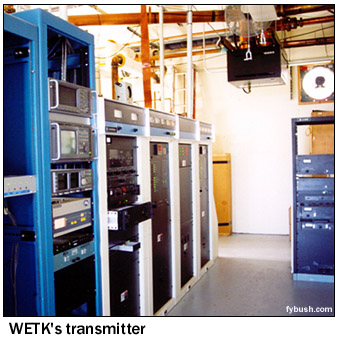 Behind a wall is
the original RCA TTU-30A transmitter that was WETK's first; it's
so large that it's hard to imagine it being trucked up the twisty
dirt road to the summit. Tucked almost inconspicuously along
the side of the RCA behemoth is WVPS's Harris transmitter, tiny
by comparison. There's a small bedroom next to the transmitter
room, for use in the event an engineer can't get down the mountain
in severe winter weather.
Behind a wall is
the original RCA TTU-30A transmitter that was WETK's first; it's
so large that it's hard to imagine it being trucked up the twisty
dirt road to the summit. Tucked almost inconspicuously along
the side of the RCA behemoth is WVPS's Harris transmitter, tiny
by comparison. There's a small bedroom next to the transmitter
room, for use in the event an engineer can't get down the mountain
in severe winter weather.
From here, a path leads around the side of the building, past the Vermont Public TV microwave links and up to the nose of the mountain. It's closed to climbers these days, because the very low WETK and WCAX towers create some RF "hot spots" at the peak where RF levels exceed OSHA guidelines.
Therein lies a dilemma that's occupied plenty of time and money for the Mansfield broadcasters over the last decade: they'd like to raise these antennas, and create tower space on the mountain for digital TV in the process - not to mention to move the WVPS signal to a panel antenna that would eliminate some multipath issues - but they're hemmed in by some very restrictive Vermont laws.
In 1970, just two years after the channel 22 tower went up, Vermont lawmakers passed Act 250, the "Land Use and Development Law." While the law has done some good things - preventing suburban sprawl and preserving much of Vermont's rural character - it's been a headache for broadcasters, who have found it exceptionally hard to get new tower facilities built.
That's especially true on a site as prominent as Mansfield, where the most rabid of the anti-development forces would like to see the towers disappear completely. That won't happen; just about all sides of the debate concede that TV service to Vermont is dependent on the use of Mansfield as a transmitter site - but the broadcasters here have been hung up in negotiations for years now about the construction of a new tower on or near the "nose" to replace the aging WCAX and WETK/WVPS facilities, and perhaps the WVNY tower as well.
In the meantime, broadcast development on the peak has been stalled; WCAX has a construction permit for WCAX-DT on channel 53 that remains unbuilt, while WVNY-DT 16 and WETK-DT 32 remain at the application stage. Several other stations would like to locate on the peak: Fox affiliate WFFF-TV, channel 44, held a CP to broadcast from the channel 22 tower but ended up signing on in 1998 from the Terry Mountain site of WPTZ-TV across the lake in New York, while WLKC-FM on 103.3, licensed to Waterbury, would like to move here from nearby (but lower) Bolton Mountain.
Will a new tower ever rise here? Stay tuned for the next chapters in the nearly half-century broadcast history of this historic peak, and check back next week as we head down the mountain and see some of Burlington's other broadcast sites!
- Previous Site of the Week: Booth Hill, Trumbull, CT
- Next Week: Burlington, VT
- How can you help support Site of the Week? Click here!
- Submit your suggestions for a future Site of the Week!
